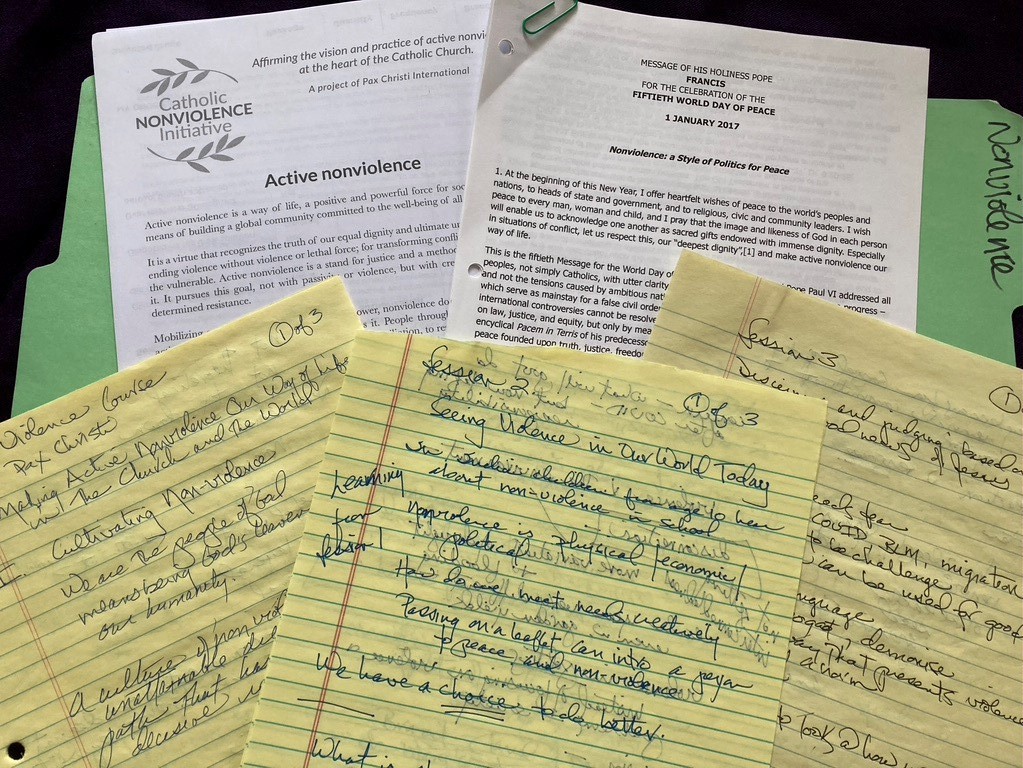This article was originally published in the Winter 2020-2021 Edition of JUST Words.
Susan M. Hickman is a Springfield Dominican associate and a member of the sisters’ Justice, Peace, and Integrity of Creation Committee.
Recently I was privileged to participate in a Pax Christi United Kingdom workshop on nonviolence. The sessions took place over five weeks and each included prayer, scripture, presentation, reflection, and discussion in small groups. Participants came from across the globe, despite the inconvenience for people in many time zones.
This workshop, “Making Active Nonviolence Our Way of Life in the Church and in the World,” came to our attention as we on the Springfield Dominican Sisters’ Justice, Peace, and Integrity of Creation Committee (JPIC) were completing our study of Choosing Peace: The Catholic Church Returns to Gospel Nonviolence. This book was published after the April 2016 conference, Nonviolence and Just Peace, organized by Pax Christi International and the Pontifical Council for Justice and Peace, and was encouraged and blessed by Pope Francis. Learning of the workshop was serendipitous even though the time zone difference for the sessions was not; we started at 5:00 am CST! The discussions and learnings were rich. Here are a few of the learnings, many of which lead to further reflection, study, and dialogue.
Workshop Takeaways
What is “active nonviolence?” It certainly is not passive or submissive. Active nonviolence is developed as individuals and groups seek to find creative, life-affirming ways to resolve conflict, overcome oppression, establish justice, and protect Earth. As Martin Luther King, Jr., wrote as part of his first principle for nonviolence, “It is active nonviolent resistance to evil. It is aggressive spiritually, mentally, and emotionally.”
One of the sessions called us to reflect on how we see violence in our world today. It is impossible to define nonviolence without defining violence. We most often think of violence as physical, as in war, in criminal assaults, and attacks. But violence exists everywhere, at every level, from the personal to the global: in language, in economic and political institutions, and in industrial exploitation of workers and the environment. Seeing violence in all these spheres leads us to ask: How can we meet people’s needs creatively without recourse to violence? How can we educate ourselves and future generations for nonviolence? How can we help people see the pervasive violence against Earth? How can we respond to persons displaced by violence of any kind, without understanding our deep interconnection with all of creation? Each of these questions calls for study, reflection, contemplation, and dialogue.
Pope Francis calls us to nonviolence based on Jesus’ life and teaching. Our own strivings to live from our gospel values also call us to nonviolence. As Francis said in his 2017 message for the fiftieth World Day of Peace, “I wish peace to every man, woman, and child, and I pray that the image and likeness of God in each person will enable us to acknowledge one another as sacred gifts endowed with immense dignity. Especially in situations of conflict, let us respect this our ‘deepest dignity.”’
In his message Francis reminds us “Jesus himself lived in violent times. Yet he taught us that the true battlefield, where violence and peace meet, is the human heart: for ‘it is from within, from the human heart, that evil intentions come’ (Mk 7:21).”
From one of our small group discussions came the insight that Jesus’ response of nonviolence is rooted in his awareness of all that was around him, and of its blessedness. Jesus invites us all to see that blessedness and respond out of it. This seeing with love, seeing with the eyes of our hearts, needs to be nurtured. We are thus called to contemplation, study, prayer, and dialogue.
Another learning from the workshop struck me especially forcefully as a member of JPIC: We must recognize the connection of every effort toward justice with nonviolence. In his 2019 World Day of Peace message Pope Francis reminded us that peace is central to the mission of Christ’s disciples and a challenge to be taken up again and again. Our justice efforts gain immeasurably when we mindfully remember to see them through the lens of nonviolence.
Ways To Practice Nonviolence
Active nonviolence is just that— active. Here are a few insights gleaned from our discussions to orient ourselves more fully toward nonviolence:
Find ways to affirm and celebrate nonviolence (e.g., the Dominican Month for Peace each December).
Be mindful of the language we use so we do not scapegoat, demonize, or promote fear.
Sit with the question: How would the world look if nonviolence was our first choice in working to resolve conflicts?
Cultivate nonviolence in ourselves. Understand that nonviolence informs everything we do: our relationships, conversations, what we buy, what we choose to read, watch, and listen to. Practice making nonviolence our own first choice in response to conflict and injustice.
Respond to conflict rather than reacting to it. Give ourselves and others an opportunity to pause and to think, to enable a creative response to come forth. Sometimes even a simple cough can interrupt what is becoming a reactive interchange and give space for a more considered response. Jesus drawing in the sand before he responds to the mob demanding the adulteress be stoned is one of my favorite examples.
Participate in trainings about and for nonviolence.
This workshop reminded me that active nonviolence is a stand for justice and a method to help create justice. I look forward to further contemplation, study, and dialogue about these important lessons.


